- Joined
- Apr 30, 2005
- Messages
- 34,710

kenny|1322677735|3071659 said:Thanks all.
I would only buy the loose stone.
I feel Gueblin is reputable enough to trust their grades, but customers vary and this one would also want the additional information provided by the AGL Prestige report.
If I pursue this stone I'll also ask if it has a window and ask for face up pics.
Tristan, do you do windows?
Here's our house.
TL|1322684369|3071733 said:It's not that GRS, Gueblin, SSEF, GIA, etc. . . are not trustworthy, but the one thing they do not have that AGL has are color and tone quality in comparison to huge database of other material. If you are a sapphre expert, and you have a great eye and have judged zillions of sapphires from all over the world, then perhaps you don't need an AGL, but I feel that it not only provides true scientific quality, but it gives the gem extra value as well to the eyes of other gem afficionados. I simply do not think these are labs hold their weight against the prestige report.
Harriet|1322707127|3071968 said:A true gem aficionado does not need to use the Prestige Report as a crutch. His or her 'eye' should suffice.
gongli|1322710773|3072005 said:another thing that i have yet to figure out is what are you actually buying... the lab report or the stone? if the lab report says its an awesome kashmir or if it says its a crappy, say, thai, the stone is still the same. when you take it out and look at it, why does the lab report in the drawer matter so much? if it says its awesome, i would probably sit there and look at it for a while trying to pick out what makes it so remarkable (since i actually forgot how the 3000 kashmir stones i saw looked back before i taught richard hughes everything he knows). and if the report says its crappy then i'll probably look at it for a little while, find an inclusion or something, and then send it back without really knowing why. so now i think maybe the lab report grade is overrated. id like to think that if i had the money, id buy it, and look at it, and make the decision myself.
almost totally off topic, today i went into a jewelry shop and saw a ruby ring with a nice saturated color and the glow, 2 small black eye-visible inclusions in a corner but still a nice piece. looked at it for a while, 1.5c with 2 diamond .75tcw side stones, 14k gold, $2.5k in a bricks-and-mortar. i asked the lady if it was heated or beryllium, she stammered and said it's normally treated and heated like all rubies, and that she didn't have to disclose anything. the ruby was looked very nice, and at that price it's probably atleast heated. im not going to buy it, but i do like it, and i don't think i'd want anything more than the gembrief lab report to make a decision if i were to buy it. (i actually think that despite the fact that it's nice, it must be overpriced since its in a bricks and mortar, and i dont want the diamonds anyway.)
now with a kashmir, you're paying real money for the report to say kashmir, unless your eye can tell that it's kashmir.... but the thing is, i think your eye can actually tell in some cases. things are sometimes famous for a reason... but how different is it, and how much is that worth?
TL|1322714160|3072026 said:Yeah, but Kenny, just because a stone is from Kashmir doesn't make it great. It can be a dud. Likewise, there are sapphires from far less premium origins that look like nice Kashmir sapphires.
Again, take a detailed look at the AGL prestige report (the more comprehensive one) on their website. They don't say, "vivid," "awesome," "royal blood blue" or anything like that. They provide numerical data on the quality of saturation and tone, and from that, it is easier to identify the true quality, which is in their overall rating. This data is compared to their huge volume of data for a particular species of gem. I know I keep repeating myself, but these other lab reports don't provide that kind of data.
Barrett|1322717051|3072047 said:Kenny your post seem to grow on me every day.
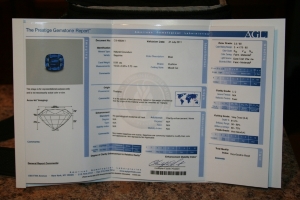
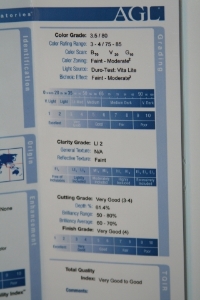
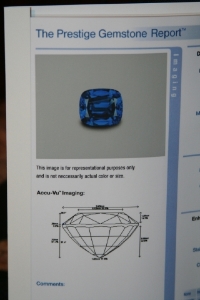
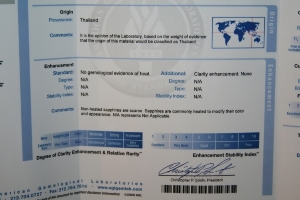
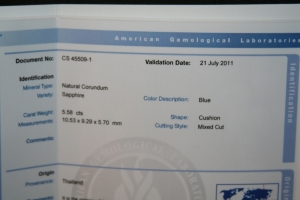

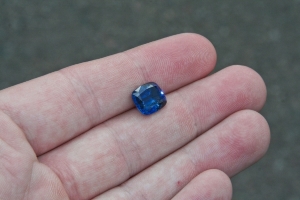
gongli|1322755782|3072240 said:justin, that's an incredible stone. im sure there's plenty more from thailand, and plenty of not so great kashmirs out there. my mistake to have mentioned thai as if it were bad, sorry!
kenny, all i meant was that i personally don't understand how and why the origin and expert's report matters in terms of a stone's price. if the gents buying certified diamonds for their fiancees can't pick out the stone using their own eyes and sensibility, then from my personal point of view, they are paying (a lot) for the paper of the expert who they think can. why would they do this? a few good reasons: resale, insurance, and the paper also shows the fiancee how much the fellow shelled out for her, even though perhaps neither of them can tell from the stone.
if i may say so, i think your fcd collection is incredible, and i've personally learnt alot by reading your posts when you find stones to compare with the ones in your collection. for example, you found a remarkable pair of slightly brownish pink (i think) diamonds that were much cheaper than the purely pink diamonds. i couldn't have been able to tell the difference, and i don't think the difference woud've been worth it. if someone who couldn't tell bought the pure pink because of the report, would you say they paid for the stone or the paper?
if i were collecting at your level, then i would also use lab reports, but i would only hope to have your experience, eye, and command of all the subtleties.
gongli|1322755782|3072240 said:justin, that's an incredible stone. im sure there's plenty more from thailand, and plenty of not so great kashmirs out there. my mistake to have mentioned thai as if it were bad, sorry!
gongli|1322779058|3072530 said:I agree the report tells you some important scientific and color value facts about the stone you're paying for. i think the grading report also suggests a little bit about the fineness of the 4c's of a stone and therefore its resale or insurance value. but you learn the resale value only when you resell it, not from the report.
despite popular opinion, as far as i can tell the 4c's (which you can see with your eyes) are almost irrelevant in terms of individual stone value and in terms of overall market volume. the main factors are origin and treatment, neither of which you can see. a treated (or synthetic) stone can be vastly superior in the 4c's and be worth almost nothing compared to an untreated stone from a prestigious origin - which can only be determined by a lab, not by your own eyes. and the market for heavily treated stones (such as be-sapphire) seems to be huge from what i can tell, ranging from macy's to costco and even to tiffany's (see their disclosures on their websites). these stores profit from selling cheap, heavily treated stones to people who don't know about treatment, and that spread, which has nothing to do with the 4c's, seems to me to be the mainstay of the jewelry trade. (i once bought, and luckily thanks partly to PS, returned, a be-treated sapphire from macy's and that's kind of what got me started reading about gems and PS)
